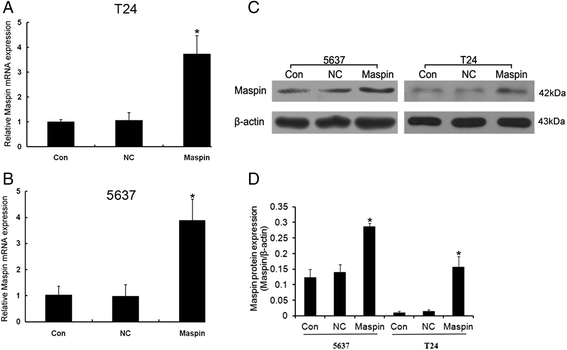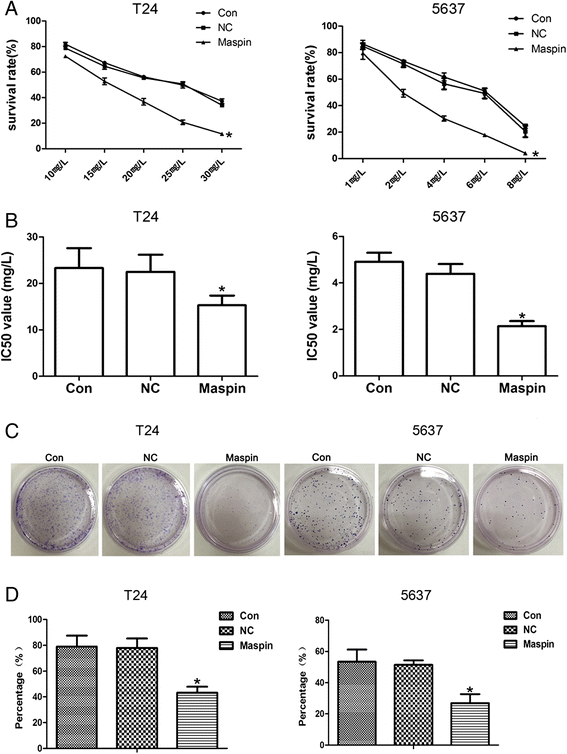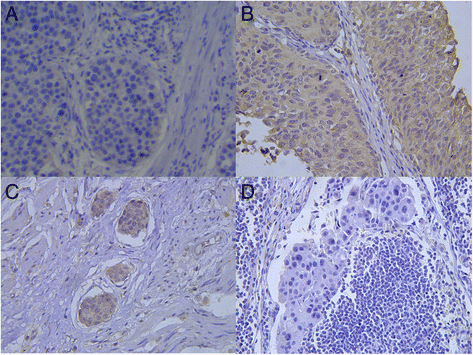Maspin enhances cisplatin chemosensitivity in bladder cancer T24 and 5637 cells and correlates with prognosis of muscle-invasive bladder cancer patients receiving cisplatin based neoadjuvant chemotherapy
- PMID: 26733306
- PMCID: PMC4702361
- DOI: 10.1186/s13046-015-0282-y
Maspin enhances cisplatin chemosensitivity in bladder cancer T24 and 5637 cells and correlates with prognosis of muscle-invasive bladder cancer patients receiving cisplatin based neoadjuvant chemotherapy
Abstract
Background: Maspin, a non-inhibitory member of the serine protease inhibitor superfamily, has been characterized as a tumor suppressor gene in multiple cancer types. Chemotherapeutic insensitivity is one of major obstacles to effectively treating muscle invasive bladder cancer (MIBC). This study was conducted to investigate the role and probable mechanism of Maspin enhancing cisplatin chemosensitivity of bladder cancer in vitro and MIBC patients.
Methods: Maspin expression was quantified by qRT-PCR in two MIBC cell lines (T24 and 5637). After successful established Maspin overexpression model by lipidosome transfection, MTT and cell apoptosis assay were used to assess the MIBC's cisplatin sensitivity. Western blot method was used to test PI3K/ AKT/mTOR signal passway and apoptosis related molecules Caspase3 and Bcl-2. Additionally, we evaluated Maspin expression and prognosis in 62 MIBC cases who underwent cisplatin based neoadjuvant chemotherapy (NACT) using immunohistochemistry.
Result: Upregulate Maspin expression could enhance the chemosensitivity induced by cisplatin in T24 and 5637 cell lines. The cell viability, cloning ability and IC50 were reduced while apoptosis rate was upregulated when cells were transfected Maspin. Phospho(p)-AKT, PI3K, mTOR, and Bcl-2 expression were significantly decreased, whereas Caspase3 was greatly increased in the Maspin group. In the clinic study, there was significant correlation between Maspin expression and overall survival (OS) and progression-free survival (PFS) rate in MIBC patients who received cisplatin based NACT.
Conclusion: Maspin could enhance cisplatin chemosensitivity in T24 and 5637 cell lines. Its expression correlated with prognosis of MIBC patients who received cisplatin based neoadjuvant chemotherapy.
Figures







Similar articles
-
VEGF-C inhibition reverses resistance of bladder cancer cells to cisplatin via upregulating maspin.Mol Med Rep. 2015 Aug;12(2):3163-9. doi: 10.3892/mmr.2015.3684. Epub 2015 Apr 24. Mol Med Rep. 2015. PMID: 25936422
-
Inhibition of IGFBP-2 improves the sensitivity of bladder cancer cells to cisplatin via upregulating the expression of maspin.Int J Mol Med. 2015 Aug;36(2):595-601. doi: 10.3892/ijmm.2015.2250. Epub 2015 Jun 17. Int J Mol Med. 2015. PMID: 26080829
-
5-Aza-2'-deoxycytidine enhances maspin expression and inhibits proliferation, migration, and invasion of the bladder cancer T24 cell line.Cancer Biother Radiopharm. 2013 May;28(4):343-50. doi: 10.1089/cbr.2012.1303. Epub 2013 Apr 9. Cancer Biother Radiopharm. 2013. PMID: 23570371
-
Pharmacokinetic and toxicity considerations in the use of neoadjuvant chemotherapy for bladder cancer.Expert Opin Drug Metab Toxicol. 2015 May;11(5):731-42. doi: 10.1517/17425255.2015.1005600. Epub 2015 Jan 21. Expert Opin Drug Metab Toxicol. 2015. PMID: 25604887 Review.
-
Forty years of cisplatin-based chemotherapy in muscle-invasive bladder cancer: are we understanding how, who and when?World J Urol. 2019 Sep;37(9):1759-1765. doi: 10.1007/s00345-018-2544-8. Epub 2018 Nov 3. World J Urol. 2019. PMID: 30392011 Review.
Cited by
-
A potential prognostic lncRNA signature for predicting survival in patients with bladder urothelial carcinoma.Oncotarget. 2017 Feb 7;8(6):10485-10497. doi: 10.18632/oncotarget.14441. Oncotarget. 2017. PMID: 28060759 Free PMC article.
-
LncRNA DDX11-AS1: a novel oncogene in human cancer.Hum Cell. 2020 Oct;33(4):946-953. doi: 10.1007/s13577-020-00409-8. Epub 2020 Aug 9. Hum Cell. 2020. PMID: 32772230 Review.
-
MiR-22 suppresses the growth and metastasis of bladder cancer cells by targeting E2F3.Int J Clin Exp Pathol. 2020 Mar 1;13(3):587-596. eCollection 2020. Int J Clin Exp Pathol. 2020. PMID: 32269700 Free PMC article.
-
Synthetic tetracycline-controllable shRNA targeting long non-coding RNA HOXD-AS1 inhibits the progression of bladder cancer.J Exp Clin Cancer Res. 2016 Jun 21;35(1):99. doi: 10.1186/s13046-016-0372-5. J Exp Clin Cancer Res. 2016. PMID: 27328915 Free PMC article.
-
Emerging Biomarkers for Predicting Bladder Cancer Lymph Node Metastasis.Front Oncol. 2021 Mar 19;11:648968. doi: 10.3389/fonc.2021.648968. eCollection 2021. Front Oncol. 2021. PMID: 33869048 Free PMC article. Review.
References
-
- Herr HW. Transurethral resection of muscle-invasive bladder cancer: 10-year outcome. J Clin Oncol. 2001;19(1):89–93. - PubMed
Publication types
MeSH terms
Substances
LinkOut - more resources
Full Text Sources
Other Literature Sources
Medical
Miscellaneous

